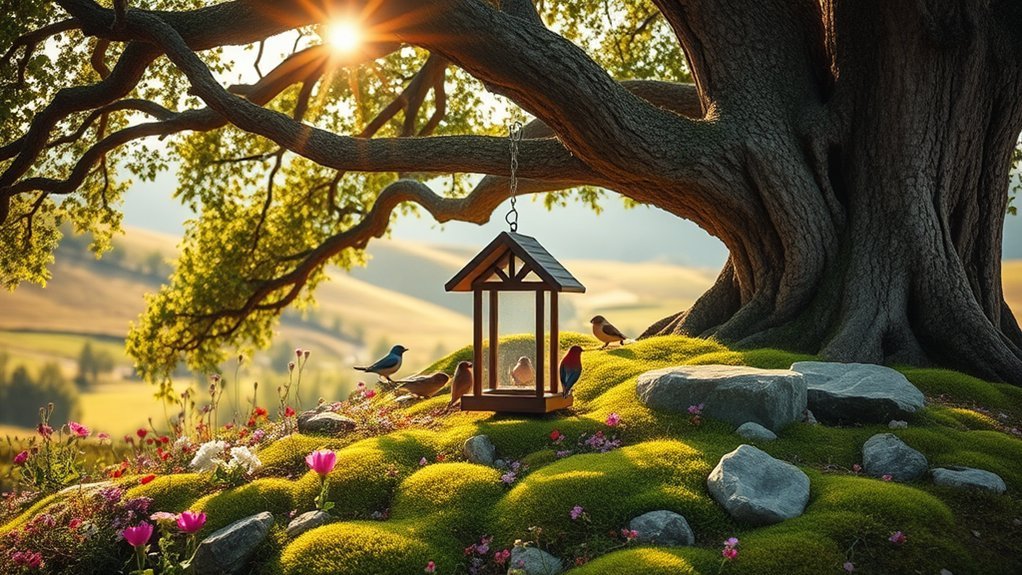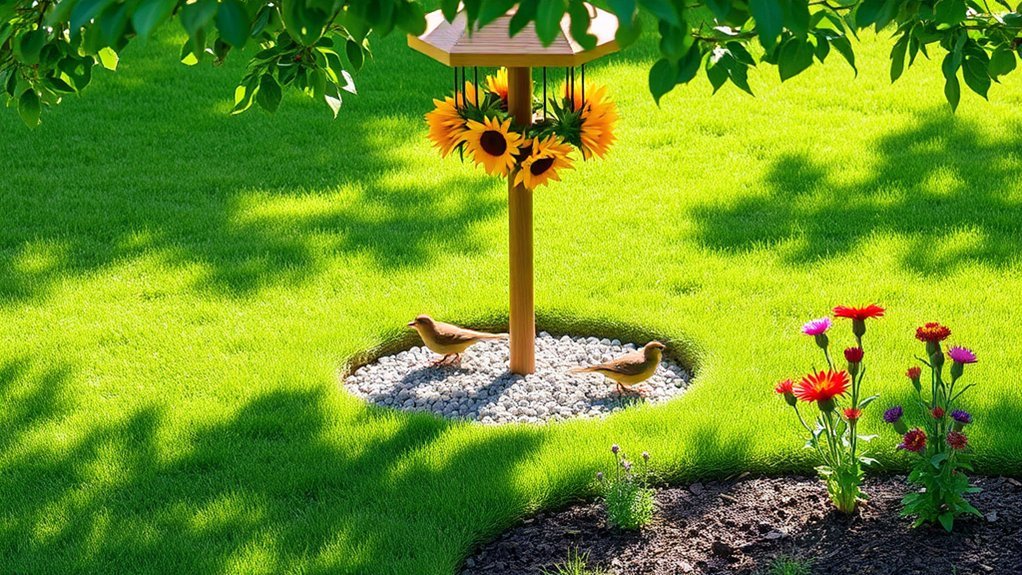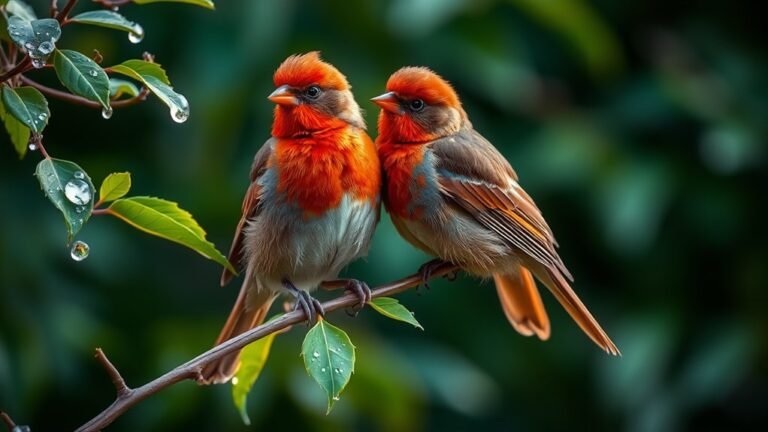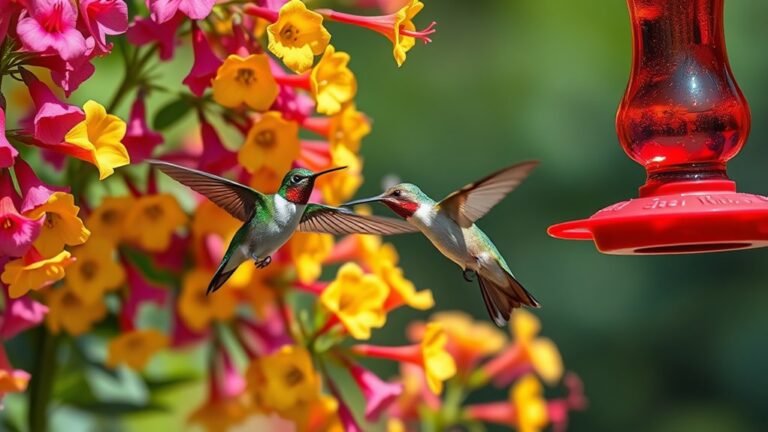12 Best Landscape Under Bird Feeder Practices
Setting up a bird feeder in your backyard can create a friendly space for birds. Choosing the right spot and adding native plants can attract many different species. Good planning can improve your garden's beauty and help local wildlife. Here are key practices to follow to build this welcoming area:
- Choose the Right Location: Place the feeder in an open area for birds to easily spot it. Avoid locations close to windows to prevent accidents.
- Plant Native Vegetation: Use local plants that provide food and shelter for birds. These plants offer seeds, fruits, and nesting materials.
- Maintain Cleanliness: Regularly clean the feeder and surrounding area. This prevents disease and keeps birds healthy.
- Create Perching Spots: Add branches or poles nearby for birds to rest on before they approach the feeder. This makes them feel secure.
- Provide Water: Include a bird bath with fresh water. Birds need it for drinking and bathing.
- Select the Right Feed: Use quality birdseed suitable for the types of birds you want to attract. Different species have different dietary needs.
- Use a Ground Feeder: Place a feeder on the ground for ground-feeding birds. This allows them to access food comfortably.
- Offer Shelter: Create hiding spots with bushes or shrubs. This provides birds protection from predators.
- Be Patient: It may take time for birds to discover your feeder. Continue to provide food and observe the activity.
- Avoid Pesticides: Refrain from using harmful chemicals in your garden. This keeps the local ecosystem safe for birds.
- Limit Noise: Keep noise levels low around the feeder. Birds are more likely to visit when they feel calm.
- Observe and Enjoy: Take time to watch the birds. Enjoy the variety of species that come to your feeder.
By following these practices, you can create an inviting space that delights both you and the birds in your area.
Key Takeaways
- Place the bird feeder in a calm area away from noise to help birds feel secure and drawn to the spot.
- Use native plants such as milkweed and coneflowers under the feeder to encourage biodiversity and attract various bird species.
- Regularly clear away fallen seeds and debris to prevent illness and keep the feeding area healthy for birds.
- Add ground cover plants to provide shelter and foraging space, improving the environment beneath the feeder.
- Provide a clean and accessible water source, like a birdbath, to attract birds and ensure they have hydration in the area.
Choose the Right Location for Your Feeder

Choosing the right location for your bird feeder is important for attracting birds.
Find a spot where the feeder is easy to see. Look for places near trees or shrubs, as these give birds safe landing spots while keeping the feeder visible.
Place the feeder where you can refill it easily, without disturbing the birds too much. Avoid busy areas, as they may scare the birds away.
A quiet corner of your yard creates a welcoming space for both you and the birds.
The right location can turn your feeder into a lively place, helping you connect with nature and enjoy watching your feathered friends.
Opt for Native Plants to Attract Birds
Bird feeders attract birds, but native plants make your yard even better. Native plants grow well in your area and provide important food for birds.
Consider adding flowers like milkweed or coneflowers. These plants bloom in different seasons and bring in a variety of birds and insects. They also offer seeds and insects that birds enjoy.
Planting native plants creates a welcoming environment in your garden. This helps celebrate nature and its cycles.
Create a Clean Feeding Area

To keep your bird feeders effective and welcoming, it's important to maintain a clean feeding area.
Begin by regularly removing old seeds and debris that can attract pests and cause diseases. Use a scoop or rake to tidy up the ground and encourage birds to visit your feeders without hesitation.
For proper maintenance, clean the feeders with a mild soap solution at least once a month. This will help keep them free from mold and bacteria, ensuring a clean feeding station.
Consider creating a specific area with gravel or mulch to catch fallen seeds, which will help reduce mess.
Incorporate Ground Cover for Shelter
Creating a welcoming space for birds involves more than just clean feeders; adding ground cover offers vital shelter and foraging areas.
Here are the benefits of incorporating ground cover:
- Habitat Variety: Ground cover creates different layers, attracting more bird species.
- Nest Protection: It helps slow down predators and provides hiding spots for nests.
- Food Source: Many ground covers draw in insects and produce seeds, giving birds natural food options.
- Soil Stability: Dense plant layers help prevent erosion and support a healthier environment.
For great ground cover, consider using low-growing plants like clover, creeping thyme, or native grasses.
These plants will enhance your garden while offering birds a safe and cozy place to thrive.
Make this simple addition and enjoy watching your feathered friends flourish!
Add a Water Source Nearby

Ground cover gives birds shelter and foraging opportunities.
Adding a nearby water source, such as a birdbath or pond, improves your landscape and attracts birds. Keep the water clean and refill it regularly to ensure good quality. Fresh water helps birds stay healthy, providing a safe place to drink and bathe.
Place the water source close to your feeder, allowing birds easy access to food and water. Your garden will be lively as colorful birds come to enjoy this vibrant ecosystem.
Happy birdwatching!
Utilize Mulch to Control Weeds
Applying a layer of mulch around your bird feeders can significantly reduce weed growth and improve the look of your garden.
Mulch offers several important benefits:
- Moisture Retention: Mulch keeps soil moist, helping both plants and birds thrive.
- Temperature Regulation: It insulates the soil, protecting plant roots from extreme temperatures.
- Aesthetic Appeal: A new layer of mulch gives a neat and unified appearance to your yard.
- Soil Enrichment: As mulch decomposes, it nourishes the soil, promoting healthy plant growth.
Using mulch is a simple and effective way to enhance your garden.
It not only keeps weeds at bay but also supports the overall health of your plants and attracts birds.
Install a Bird Bath for Refreshment
Installing a bird bath can make your yard more inviting for birds. It provides them with a place to drink and splash. When choosing a bird bath, consider materials like ceramic, stone, or durable plastic. These materials are strong and can blend nicely with your outdoor space.
To keep the water clean, refresh it often. This will attract more birds, as they prefer clean water. Place the bird bath near your bird feeder. This way, birds will find both food and water in one spot.
Select a shallow design for the bath. Adding a few pebbles at the bottom will help smaller birds bathe safely.
With proper care, your bird bath can become a lively spot for birds, letting you connect with nature and enjoy watching them.
Provide Natural Perches and Foliage
To create a welcoming space for birds, add natural perches and plants near your feeder. These additions make your area inviting. Here are some simple ideas:
- Use Native Plants: Choose local shrubs and trees. They attract birds native to your area.
- Add Perches: Install poles or trellises. Birds enjoy exploring heights.
- Provide Shelter: Plant dense bushes or small trees. This gives birds a safe place to hide.
- Vary Plant Heights: Mix different plant heights. This creates interest and offers diverse perching options.
Use Edible Landscaping for Additional Food
Enhance your landscape by adding edible plants. These plants beautify your garden and provide food sources. Edible flowers like nasturtiums and pansies bring vibrant colors and attract birds with their nectar.
Pair these flowers with berry bushes like blueberries or raspberries. These bushes offer tasty treats for you and your feathered friends.
By incorporating these plants, you create a friendly environment for birds. Your garden becomes both functional and delicious.
This edible landscaping fosters community connections through gardening and enjoying nature. Let your garden be a feast for both the eyes and the birds!
Ensure Safe Space From Predators
To help your feathered friends feel safe at the bird feeders, create a secure space away from predators.
Follow these clear steps for effective protection:
- Plant thick shrubs for natural cover.
- Install birdhouses with strong entrances to keep out larger animals.
- Use wire mesh to build barriers around the feeders.
- Place feeders away from tree branches where cats or hawks may jump from.
These simple measures will protect the birds and beautify your garden.
Maintain a Variety of Feeding Options
To attract various birds to your garden, offer a variety of feeding options.
Include different seed types like sunflower, millet, and safflower to meet their preferences.
Use feeder accessories such as seed trays and finch socks to enhance your offering. These tools help birds eat comfortably and reduce seed waste.
Colorful feeders can catch birds' attention and invite them to visit.
Regularly Monitor and Maintain the Area
Regular monitoring and maintenance of bird feeders is important. This helps create a welcoming space for birds while managing other wildlife.
Here are some simple actions you can take:
- Check the feeder and nearby areas regularly for any damage or wear.
- Remove old seeds, shells, and spoiled food to keep the area clean and free from pests.
- Clean up debris quickly to make the space enjoyable for birds and visitors.
- Keep an eye on the surrounding plants and trash to maintain a neat environment.
Frequently Asked Questions
How Often Should I Refill the Bird Feeders?
You should refill your bird feeders every few days, especially during busy feeding times. Regularly checking and filling the feeders helps ensure birds always find food in your backyard, making it a friendly place for them. Keeping the feeders full allows you to enjoy watching various bird species visit.
What Types of Birds Are Attracted to Feeders?
To attract various bird species, offer different types of seeds. Sunflower seeds attract cheerful chickadees. Finches are drawn to nyjer seeds. By experimenting with different seed blends, you can create a lively mix of birds in your yard. Enjoy watching the colorful visitors that come to your feeders.
Can I Use Synthetic Bird Feeders?
You can use synthetic bird feeders. They are very durable and can withstand harsh weather. This means they need less maintenance. Ensure that the feeders are safe for birds. Choose designs that fit well in your yard, creating a friendly habitat for visiting birds.
How Can I Stop Squirrels From Accessing the Feeder?
To stop squirrels from getting to the bird feeder, try using special feeder designs that block their access. Consider adding baffles or cages around the feeder. These tools help keep squirrels away while allowing birds to enjoy their food in peace. This way, you can create a safe place for birds to feed.
Is It Necessary to Feed Birds Year-Round?
Feeding birds year-round is not mandatory, but it can enhance their well-being, especially during migration. Regularly providing food creates a supportive environment for birds. This practice helps them meet their needs and allows you to connect more with nature.

Kashvi is a passionate bird enthusiast and nature lover who has been fascinated by the world of birds for years. With a keen eye for detail and a love for learning, Kashvi is dedicated to sharing her knowledge and insights with fellow bird enthusiasts on Avian Enthusiasts. Through her engaging and informative articles, Kashvi aims to inspire others to join her in exploring the fascinating world of birds and to promote a deeper appreciation for these incredible creatures.







